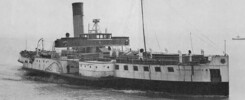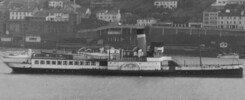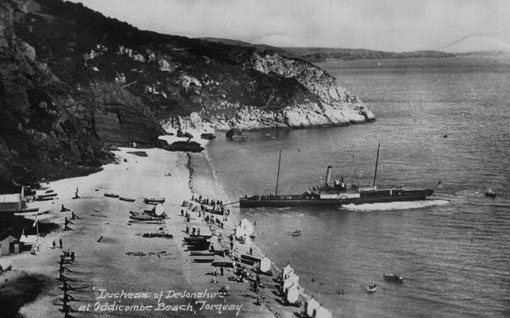
The Duchess of Devonshire (pictured above unloading at Oddicombe Beach before the First World War) was built in 1892 for the Devon Dock Pier and Steamship Co services from Exmouth and Torquay sailing along the Devon and Dorset coasts between Weymouth in the east and Plymouth in the west and calling at ports and beaches in between, a service jointly run with her slightly larger sister the Duke of Devonshire of 1896.
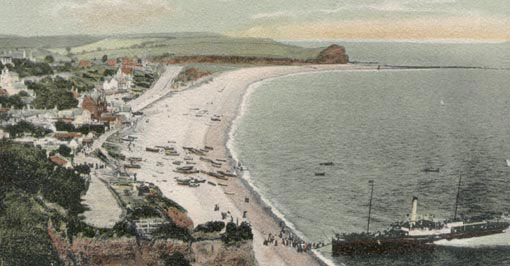
The general beach technique involved dropping a kedge anchor over the stern as the steamer approached, putting the bow onto the beach and then running the engines ahead to keep water flushing past the rudder to help steady the stern as shown in this picture of the Duchess of Devonshire at Budleigh Salterton. The technique on the Dorset coast at Lulworth Cove was slightly different as there were permanent moorings in the Cove to which to attach the stern, a small boat being used to pick up the lines and there being no need to run the engines ahead.
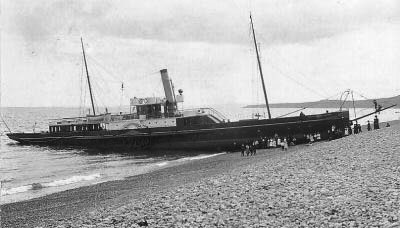
Putting the bow onto the shore required the right sort of beach with shingles and fairly steeply shelving shingles at that. As can be seen in this picture, the shingles shelve most steeply near the high water mark and disappear into sand near the low water mark, so calls either side of low tide on many of these Devon beaches were not feasible. Fortunately, temporary strandings, like that of the Duchess of Devonshire (pictured above) before the First World War, were extremely rare and, in this case, the ship floated off again on the high tide.
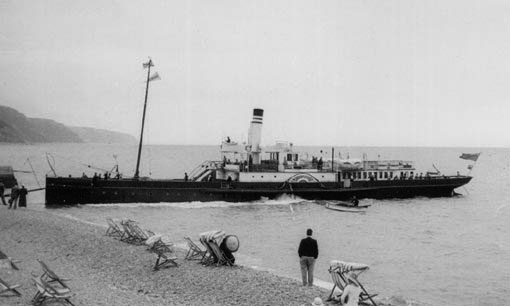
By the 1930s the service had run into decline. Competition from Cosens and P & A Campbell at Torquay had damaged the business and by 1933 the Duke of Devonshire had gone to Ireland and the Duchess of Devonshire was running under the ownership of a new company with new funnel colours, the South Devon and West Bay Steamship Company.
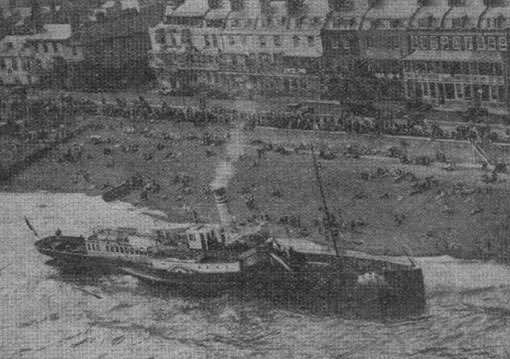
Then on August 27, 1934 towards the end of the second season of the new ownership, it all went wrong and the Duchess of Devonshire (pictured by the press in the early evening) grounded port side to on the beach at Sidmouth, making a hole in the hull in the forward saloon below the waterline and around the position of the mast.
So what went wrong? The Duchess had been calling at these beaches successfully for more than forty years and whilst, as we have seen, there had been the occasional problem, never had any steamer been wrecked whilst undertaking this common sort of beach landing even though these were sometimes made in much poorer weather conditions than on this day. The press reports at the time speak of the kedge anchor dragging but, in this case, why was the engine not put ahead in the usual way to flush water past the rudder to try to steady the stern and lift it away from the beach?
The tide tables for 1934 tell us that high water at nearby Exmouth Dock on 27th August was at 9.20am with a rise of tide of 4.38m and low water was at 2.50pm with the tide predicted to drop 0.04m below chart datum. Most low tides do not fall anywhere near chart datum and any going below are pretty unusual so this was a very low tide indeed and right in the middle of the afternoon.
We don’t know at what time the Duchess was scheduled to call at Sidmouth but the usual practice was to set off from Torquay at 10.45am with an arrival time on the beach of 12.30pm by which time, on this day, the tide would have been already half way down exposing the less steeply shelving shingle and was running away fast. Did the Duchess make calls at Teignmouth and Exmouth on the way out making an even later arrival time? Was she behind schedule making the problem worse? Was the tide below prediction, something which does happen from time to time (usually when you would prefer it wasn’t) making an already very low tide even lower?
Did her new owners schedule a trip to arrive at Sidmouth at a time almost bound to lead to a grounding? Had Capt Carter, her master, been into Sidmouth beach on days with similar high and low water times successfully before but not appreciated the unusual tidal range on this particular day. Did he know all this but just hope beyond hope that luck would be on his side and would get him in and out of the beach before the tide fell too low and stranded him?
The press reports also speak of a swell and this would have exacerbated the problem. Having half a metre of water under you in a flat calm is one thing. Having half a metre of water under you with a half metre swell and the ship is bouncing on the bottom. With a one metre swell you are aground. T W E Roche, who knew the steamers well as a local boy, recalled in his book “A Shipman’s Tale” that the Duchess caught on a newly exposed groyne and as she tried to go astern a hole was torn in the bottom. She would have floated over the top of this on days with higher states of tide.
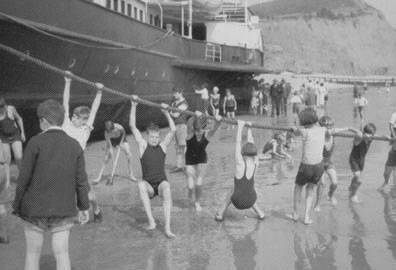
Just what a low tide this was is graphically illustrated by this picture taken the same afternoon. The water has completely left the the shelving shingle bank of the beach and the Duchess is sitting on the sand below it.
A tug was summoned and on the rising tide the stern was pulled off the beach but, unfortunately the volume of water coming in was too much for the pumps so the ship was secured with the bow onto the shore and the stern held by kedge anchors whilst a larger tug and more pumping equipment were summoned. During the night the wind was not kind, the anchors dragged and the Duchess fell in broadside onto the beach but this time starboard side to. The larger tug, Dencade, arrived at around 7pm on the rising tide and an attempt was made to tow the Duchess off but the temporary patching of the hole was not enough and, continuing to make water, the ship settled back onto another groyne, making another hole, this time under the main dining saloon aft.
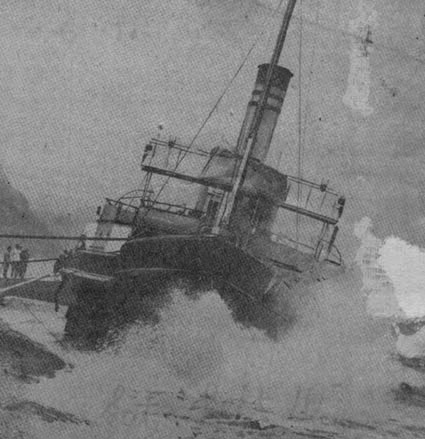
With two holes in her bottom and with poor weather in the following days making the situation worse all the time, the Duchess of Devonshire was declared a constructive total loss.
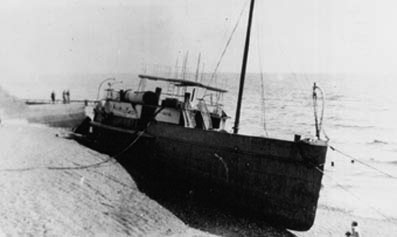
In the following months work started breaking her up where she lay on the beach…
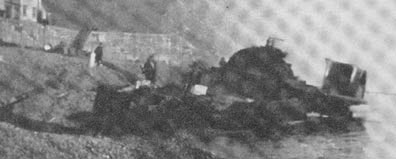
…and by early 1935 little remained of the steamer.
The Duke of Devonshire returned to the area in 1936 under the ownership of Mr Alexander Taylor but after two years was sold to Cosens of Weymouth. Renamed Consul, she continued the beach landing tradition at Lulworth Cove right up to 1964 and was scrapped in 1968. Some relics from the Duchess of Devonshire are in the Sidmouth Museum and the engine telegraph from the Duke is owned by the PSPS and is on loan for display at the Weymouth Museum.
One final thought. A number individuals, companies and other organisations, of which the South Devon and West Bay Steamship Company was one of the first, have bought elderly paddle steamers with a view to reopening services previously abandoned by their long standing operators as not financially viable. All have discovered that running these ships is logistically and financially more difficult and fraught with problems than they had imagined. Few such ventures have lasted for more than a couple or so seasons and, with the exceptions of Kingswear Castle and Waverley, none have had any lasting success in the UK. One wonders just how well the Duchess was doing in 1933 and 1934 running a service given up by the Devon Dock Pier and Steamship Company making use of exposed beaches which were very weather dependant, in a depressed economy and in competition with smaller and more cost effective motor launches running shorter trips from Torquay. It would be wrong to suggest that the South Devon and West Bay Steamship Company planned the loss of their steamer. But one cannot help but wonder if the stranding of the Duchess and the surrounding insurance implications might not, in the end, have suited her new owners rather well.
Kingswear Castle returned to service in 2023 after the first part of a major rebuild which is designed to set her up for the next 25 years running on the River Dart. The Paddle Steamer Kingswear Castle Trust is now fund raising for the second phase of the rebuild. You can read more about the rebuilds and how you can help if you can here.
John Megoran

